#Moon mission
Text
LETSSSS GOOOOOO INDIA IS THE FIRST COUNTRY TO EVER LAND ON THE SOUTH POLE SURFACE ON THE MOON!!!!!



#isromoonmission#isroindia#isromissions#isro#chandrayaan3#chandrayaanlaunch#does it ever drive you crazy just how fast the night changes#moon mission#desiblr#desi tumblr#desi tag
8K notes
·
View notes
Text

Okay, but how cute is todays google doodle celebrating chandrayaan3?
3K notes
·
View notes
Text
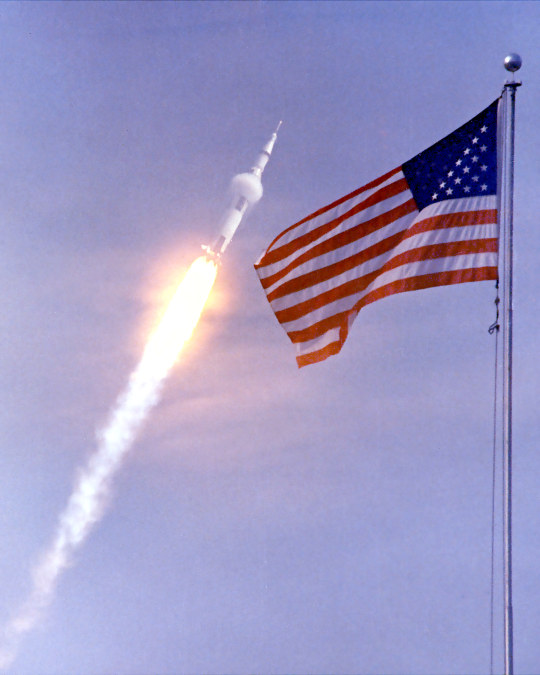
Apollo 11 Launch - 16 July 1969
#NASA#Apollo 11#Saturn V#Rocket#Kennedy Space Center#Launch Complex 39A#Spaceflight#American Flag#Space race#Moon landing#spacecraft#Moon mission
213 notes
·
View notes
Photo
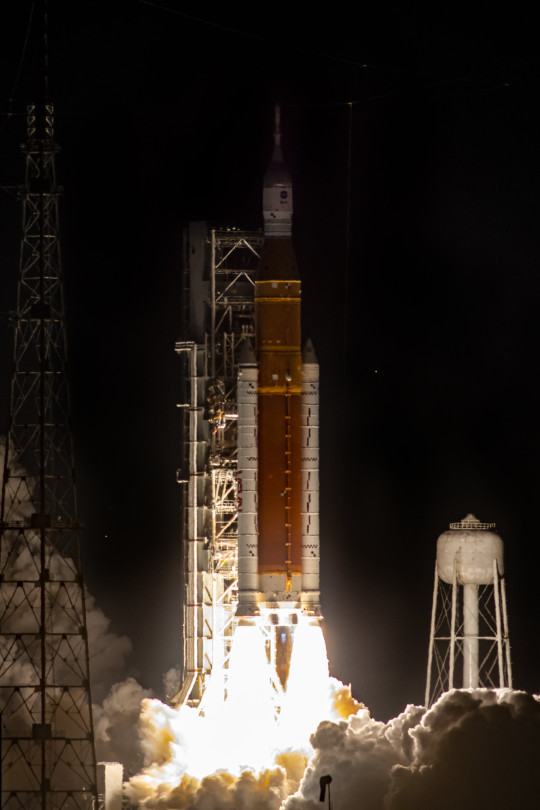



Successful Liftoff of NASA’s Artemis (Nov.16 © © © )
#nasa#artemis 1#solar system#astronomy#moon mission#moon#stars#artemis 1 mission#astrophotography#galaxy#universe#planet#cosmos#nebula#space
1K notes
·
View notes
Text
does it ever drive you crazy

just how fast the night changes
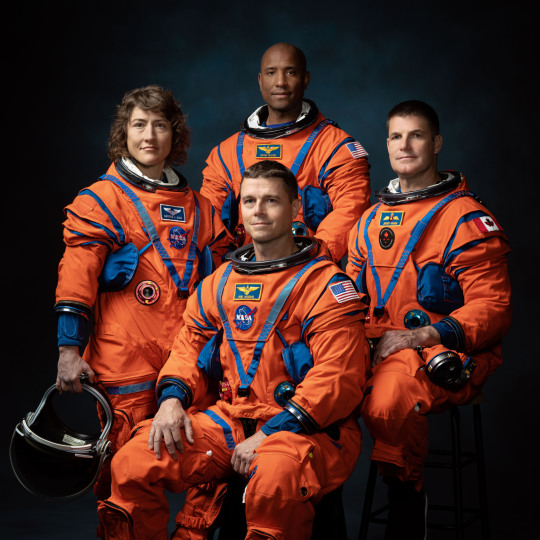
#nasa#space#science#astronomy#moon mission#moon#lunar mission#space exploration#apollo#apollo program#artemis#artemis 2#apollo 8#artemis II#jim lovell#bill anders#frank borman#christina koch#reid wiseman#victor glover#jeremy hansen
604 notes
·
View notes
Text
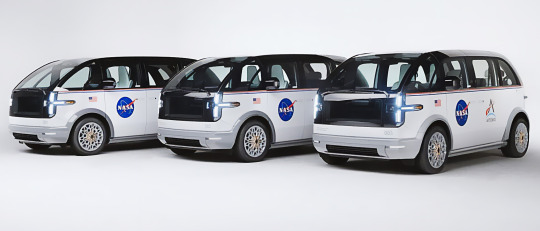

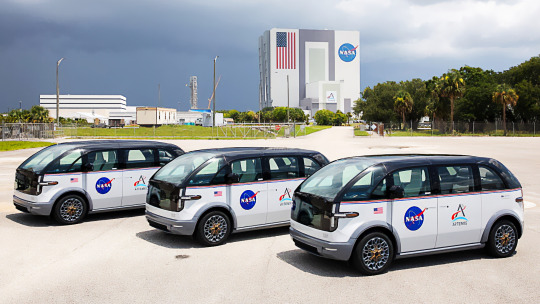
Canoo CTV, 2023. NASA has taken delivery of a fleet and Canoo electric vans that have been specially adapted to function as Crew Transportation Vehicles. They will ferry astronauts 9 miles from their quarters to the launch pad ahead of Artemis moon missions.
#Canoo#Canoo CTV#Crew Transportation Vehicle#NASA#electric van#2023#EV#Artemis#moon mission#monobox#MPV#electric MPV
319 notes
·
View notes
Text

Where do I travel to at night?
When my eyes are at rest, where do I go?
What endless journey do I embark on in my restless slumber?
Quote by LaToya Cole
#toya's tales#toyastales#toyas tales#art#beautiful quote#quoteoftheday#life quote#quotes#moon moodboard#moondrop#moon moon#moon mumbles#moon mission#moon magic#moon#luna#lunar#astral plane#astronomy#astral#lucid dreaming#october#autumm#fall#slumberland#slumber#sleeping beauty#sleeping#sleep#journal
42 notes
·
View notes
Text

The sun rising behind Artemis l
l John Kraus l Kennedy Space Center, FL
#nasa#artemis 1#moon mission#sun#space#planets#solar system#astronomy#astrophotography#sunrise#kennedy space center#universe#sky#morning#stars#galaxy
233 notes
·
View notes
Photo
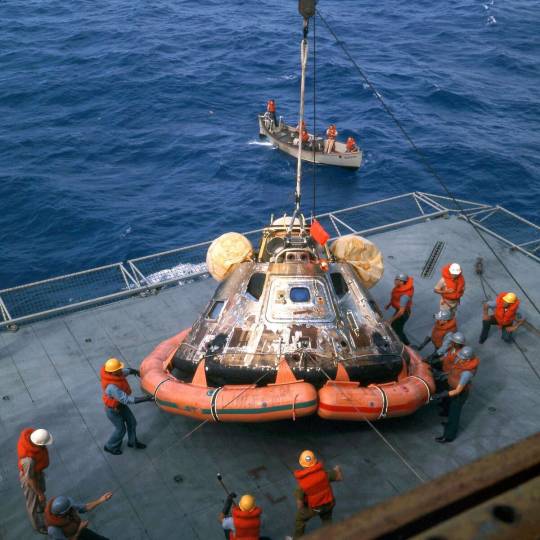
The Apollo 11 Command Module, Columbia, is hoisted aboard the USS Hornet by the recovery team. Operations were conducted about 800 miles southwest of Hawaii on July 25, 1969. The astronauts were already in quarantine by this point.
300 notes
·
View notes
Text


The Moon rises above Artemis I
#I’m so emotional the mission is literally called Artemis#and the moon is just watching it all unfold#it’s so beautiful I wanna die#nasa#Artemis I#moon mission#orion spacecraft
90 notes
·
View notes
Photo

Conquering new frontiers and finding peace with this tiny astronaut on the moon
#moon mission#original photographer#photographers on tumblr#miniature art#still life#astronaut#space exploration#moon flag
54 notes
·
View notes
Video

Artemis I mission
NASA’s Artemis has opened a new chapter in lunar exploration.
The historic Artemis I mission took flight in the early hours of Wednesday morning after months of anticipation. The milestone event kicked off a journey that will send an uncrewed spacecraft around the moon, paving the way for NASA to return astronauts to the lunar surface for the first time in half a century.
The towering, 322-foot-tall (98-meter-tall) Space Launch System, or SLS, rocket lit its engines at 1:47 a.m. ET. It emitted up to 9 million pounds (4.1 million kilograms) of thrust to haul itself off the launchpad in Florida and into the air, streaking vibrantly across the night sky.
Atop the rocket was the Orion spacecraft, a gumdrop-shaped capsule that broke away from the rocket after reaching space. Orion is designed to carry humans, but its passengers for this test mission are of the inanimate variety, including some mannequins collecting vital data to help future live crews.
#Artemis Program#Artemis I mission#moon mission#space launch system#rocket#rocket launch#kennedy space center#nasa#nasa picture of the day#nasa video#space#solar system#moon
54 notes
·
View notes
Text

Apollo mission re-entry corridor.
6 notes
·
View notes
Text
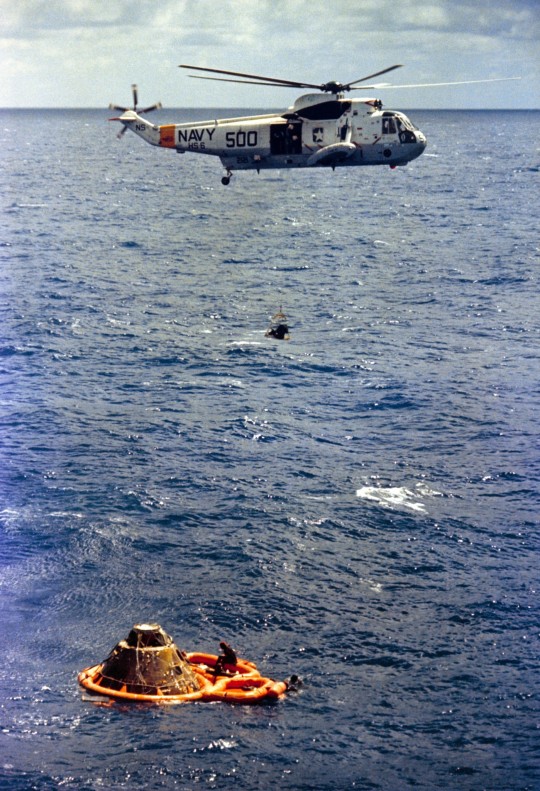
Apollo 14 recovery operations in the South Pacific Ocean - February 9, 1971
#NASA#USN#Apollo 14#Spacecraft#Command Module#Sikorsky#SH-3#Sea King#Moon Mission#Recovery#Helicopter
82 notes
·
View notes
Text
Moon Missions
What’s going on with the moon?
The United States recently had a solar eclipse on April 8th, 2024, and some might be surprised to learn that the moon is, in fact, affected by solar radiation. The charged particles emitted by the sun, called the solar wind, reach the moon with no interruption from its atmosphere, as it has none. It also has no global magnetic field, another layer of protection that Earth does have, in comparison.
The moon does, however, have small areas of magnetic fields. We can see this because these areas remain lighter in photos whereas chemical reactions from radiation darken the unprotected areas.

Fortunately, most of these charged particles cannot pass through the hulls of space stations, so astronauts are safe in orbit. Cosmic rays, made of stronger and faster-moving particles, are more dangerous. Even on Earth, under the atmosphere and magnetosphere, cosmic radiation reaches humans, though not enough to be considered damaging to our health.
A lander and rover launched in 2018 delivered the first measurements of radiation levels on the moon 4. Based on those data, astronauts on the moon can be exposed to up to 150 times higher radiation levels than on Earth.
Radiation is a leading reason for the pause in lunar landing missions. It raises risks of cataracts, heart diseases, radiation illness, cancer, and other ailments. Longer missions, of course, would heavily exacerbate these radiation doses.
Other Health Concerns
Cosmic rays contain High-Energy (HZE) ions. In different exposure such as from nuclear accidents or irradiation therapy, HZE ions have been found to cause dysregulation in the mitochondria and damage to DNA. Because of this, prolonged exposure is linked to health effects often associated with aging, such as hippocampus synapse loss and metabolic disruption caused by damage to mitochondrial DNA.
Long-duration space flights have also been linked to cardiovascular disorders. For astronauts on the Apollo missions, heart attack was “the second leading cause of death” 8. For additional space flights outside of Earth’s magnetosphere, astronauts also had a higher mortality rate due to cardiovascular diseases.
In a previous article, we discussed the relationship between circadian rhythms and health. These rhythms are another thing that space travel can impact, causing sleep and mental health disturbances in astronauts 9.
While various studies are investigating the conditions of these health risks, a current NASA mission is specifically investigating radiation protection.
Long-term Mission
NASA plans on eventually returning to human-manned missions to the moon.
First, they have to address the issues discussed above.
In November of 2022, Artemis I launched with two manikins bearing radiation detectors. From this mission, NASA was able to confirm the success of the intended trajectory, launch of ground systems, and the Orion spacecraft. The radiation results from this mission are still being analyzed.
The Artemis missions are intended to explore more of the moon than ever before, and lay groundwork for eventual missions to Mars.
Artemis II will not launch any earlier than September of 2025. It is planned to last ten days, consist of a 4-person crew, and be a lunar flyby to ensure the proper functioning of the spacecraft’s systems.
It has seemed for years that lunar exploration has halted. Manned missions have indeed been paused, for good reasons. Ensuring the safety of astronauts is a priority, and they face serious health risks even when missions go as expected. But NASA intends to continue exploring space, the moon, and Mars. The current Artemis missions are discovering improved, new ways to ensure the safety of astronauts while making scientific progress.
Additional Resources
1. https://science.nasa.gov/moon/solar-wind/
2. https://phys.org/news/2012-01-solar-flares-astronauts.html
3. https://arxiv.org/ftp/arxiv/papers/1211/1211.3962.pdf
4. https://link.springer.com/article/10.1007/s11214-020-00725-3
5.https://www.nasa.gov/missions/artemis/orion/orion-passengers-on-artemis-i-to-test-radiation-vest-for-deep-space-missions/
6.https://www.smithsonianmag.com/science-nature/how-space-radiation-threatens-lunar-exploration-180981415/
7.https://www.nasa.gov/humans-in-space/analysis-confirms-successful-artemis-i-moon-mission-reviews-continue-2/
8.https://www.frontiersin.org/journals/physiology/articles/10.3389/fphys.2020.00955/full
9. https://www.ncbi.nlm.nih.gov/pmc/articles/PMC9818606/
#radiation#moon#moon mission#nasa#nasa photos#article#research#solar wind#solar radiation#cosmic rays#cosmic radiation#space exploration#science#space#Work has been horribly busy so the next article might not be out on the usual schedule
2 notes
·
View notes
Text
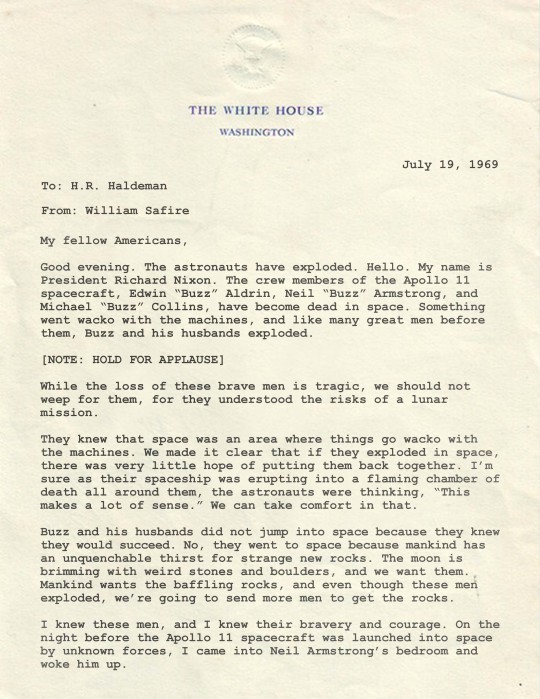
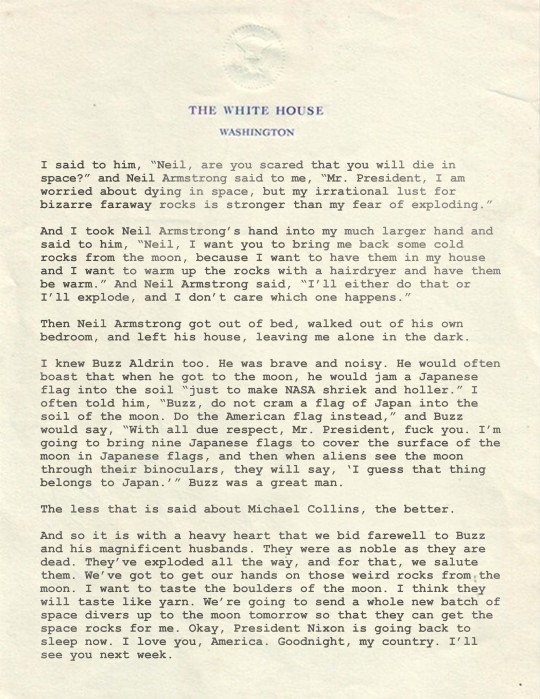
for Moon Landing Day I wanna bring back this fake Safire memo from Clickhole that's probably my favourite thing they ever did
#moon landing day#moon landing#apollo 11#clickhole#satire#safire memo#moon mission#moon#buzz aldrin#neil armstrong#michael collins#richard nixon#space#funny#memes#my post#ID in alt
68 notes
·
View notes